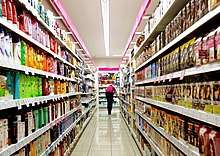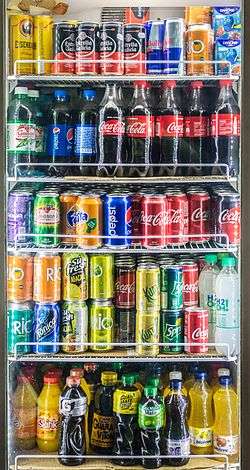Fast-moving consumer goods


Fast-Moving Consumer Goods (FMCG) or Consumer Packaged Goods (CPG) are products that are sold quickly, and at relatively low cost. Examples include non-durable goods such as packaged foods, beverages, toiletries, over-the-counter drugs, and other consumables.[1][2] There is a large online market called brand communities that have created the demand for these types of products. The ongoing growth of the internet over the past quarter century has created the demand. According to the AGOF internet facts, 73% of Germany's population are online. Additionally, 83.7% of internet users claim to use the web to search for information and 68.3% shop online[3]. Vendors use this to their advantage to connect with consumers and market their goods. This can then be used to target those consumers who show high identification with a specific brand or good. Marketers of FMCG have discovered this capability and are using it to build relationships with their customers to understand what they want.
Many fast moving consumer goods have a short shelf life, either as a result of high consumer demand or because the product deteriorates rapidly. Some FMCG, such as meat, fruit, vegetables, dairy products, and baked goods, are highly perishable. Other goods, such as pre-packaged foods, soft drinks, candies, and toiletries have high turnover rates. Sales are sometimes influenced by holiday or seasonal periods.
Packaging is critical for FMCG. Logistics and distribution systems often require secondary and tertiary packaging to maximize efficiency. Unit or primary packaging protects products and shelf life while providing product information to consumers.
Though the profit margin made on FMCG products can be relatively small, they are generally sold in large quantities; thus, the cumulative profit on such products can be substantial. FMCG is a classic low margin and high volume business. According to BASES, 84% of fast-moving consumer goods professionals are under more pressure to quickly bring new products to market than they were five or ten years ago. With this in mind, 47% of those surveyed confessed that product testing suffers most when deadlines are accelerated.[4] The most innovative FMCG companies are now adopting agile design Agile Marketing and development principles which allow them to remain nimble in response to market demand and customer feedback.
Characteristics
The following are the main characteristics of FMCGs:[1]
- From the consumer's perspective
- Frequent purchases
- Low involvements (little or no effort to choose the item)
- Low prices
- Short shelf life
- Rapid consumption
- From the marketer's perspective
- High volumes
- Low contribution margins
- Extensive distribution networks
- High stock turnover
Rural Consumers
Consumers in rural areas would typically purchase goods from nearby towns and villages. Recently, there has been an ideological shift in consumer purchase behavior shifting towards purchasing locally that has prompted the need of promotional efforts on a local basis in order to generate brand awareness in small towns. FMCGs play a large part in the economy as they are seen as inelastic products that touch every life in one way or another. Businesses that supply FMCGs to a community can help provide numerous employment opportunities in rural areas as well as drive down the cost of such products in those areas. For instance, the FMCG sector in India is the 4th largest sector in its economy and generates employment for more than 3 million people in downstream activities.[5]
ISIC definition
The retail market for FMCGs includes businesses in the following International Standard Industrial Classification (ISIC) (Revision 3) categories:[6]
- ISIC 5211 retail sales in non-specialized stores
- ISIC 5219 other retail sales in non-specialized stores
- ISIC 5220 retail sales of food, beverages and tobacco in specialized stores
- ISIC 5231 retail sales of pharmaceutical and medical goods, cosmetic and toilet articles
- ISIC 5251 retail sales via mail order houses
- ISIC 5252 retail sales via stalls and markets
- ISIC 5259 wholesale goods
- ISIC 5269 wholesale medical prescriptions
Supplier industries for FMCGs include:
- 1512 fish and fish products
- 1513 fruit and vegetables
- 1514 vegetable and animal oils and fats
- 1520 dairy products
- 1531 grain mill products
- 1532 starches and starch products
- 1533 animal feeds
- 1541 bakery products
- 1542 sugar
- 1543 cocoa, chocolate and sugar confectionery
- 1544 macaroni, noodles, couscous
- 1549 other food products
- 1551 spirits, ethyl alcohol
- 1552 wines
- 1553 malt liquors and malt
- 1554 soft drinks, mineral waters
- 1600 tobacco products
- 2101 pulp, paper and paperboard
- 2102 corrugated paper, containers
- 2109 other articles of paper and paperboard
- 2424 soap and detergents, cleaning preparations, perfumes
- 2430 men's and women's inner garments, shaving gels, deodorants
Fast-moving consumer electronics
Fast-moving consumer electronics are typically low-priced generic items or can easily be substituted. Examples of consumer electronics include: mobile phones, MP3 players, game players, earphones, headphones, OTG cables, and digital disposable cameras.
See also
References
- 1 2 Ramanuj Majumdar (2004). Product Management in India. PHI Learning. pp. 26–27. ISBN 978-81-203-1252-4. Retrieved 2010-06-19.
- ↑ Sean Brierley (2002). The advertising handbook By Sean Brierley (2, illustrated ed.). Routledge. p. 14. ISBN 978-0-415-24391-9.
- ↑ Meister, S. (2012). Brand communities for fast moving consumer goods: An empirical study of members behavior and the economic relevance for the marketer. Wiesbaden: Springer Gabler.
- ↑ United States : Nielsen Bases Debuts Faster In-Home Product Testing Solution for Fast-Moving Consumer Goods. (2018, August 23). Mena Report. from http://www.highbeam.com/doc/1G1-551430065.html?refid=easy_hf
- ↑ Singaravelu, Dr. K. (October 2013). "RURAL CONSUMER BEHAVIOUR ON FAST MOVING CONSUMER GOODS" (PDF).
- ↑ Aydın Çelen; Tarkan Erdoğan; Erol Taymaz (June 2005). "Fast Moving Consumer Goods Competitive Conditions and Policies" (PDF). Economic Research Center, Middle East Technical University. Retrieved 2007-07-09. , p.2-4